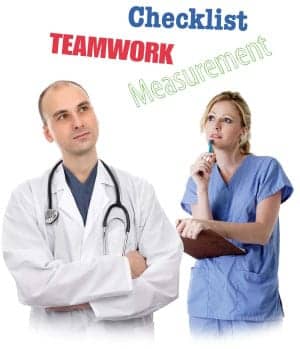
Each year, medical errors are estimated to result in hundreds of thousands of unnecessary deaths and more than 1 million injuries. Regardless, most of the deaths that are related to medical errors go unnoticed.
In 2000, The Institute of Medicine published the book To Err Is Human: Building a Safer Health System,1 which claimed that the problem in medical errors is not about bad people but is about good people who are working in poorly realized systems that need to be made safer.
Peter J. Pronovost, MD, PhD, is a practicing anesthesiologist and critical care physician, teacher, researcher, author, and international patient safety leader at Johns Hopkins University School of Medicine in Baltimore. He recently established the Quality and Safety Research Group (QSRG) to advance the science of patient safety after watching his father die as a result of medical error.
This and other unnecessary, medical-error-driven untimely deaths led Pronovost to record his observations and experiences of medical errors in his recent book, Safe Patients, Smart Hospitals: How One Doctor’s Checklist Can Help Us Change Health Care from the Inside Out (Hudson Street Press; 2010).
As detailed in his biography, Pronovost and his research team are dedicated to improving health care through methods that are scientifically rigorous but feasible at the bedside. He holds a doctorate in clinical investigation from the Johns Hopkins Bloomberg School of Public Health; and he has written more than 200 articles and chapters in the fields of patient safety, ICU care, quality health care, evidence-based medicine, and the measurement and evaluation of safety efforts.
Pronovost is also a frequent speaker on the topics of quality and safety leadership and implementation of large-scale change. He chairs the JCAHO ICU Advisory Panel for Quality Measures and the ICU Physician Staffing Committee for the Leapfrog Group, and serves on the Quality Measures Work Group of the National Quality Forum.
He also serves in an advisory capacity to the World Health Organization’s World Alliance for Patient Safety, and is leading WHO efforts to improve patient safety measurement, evaluation, and leadership capacity globally. He has won several national awards for his research, including the 2004 John Eisenberg Patient Safety Research Award.
In 2008, Pronovost was named one of the world’s “most influential people” of the year by TIME magazine for his work in patient safety. He is the recipient of the MacArthur Fellowship and was cited by the US House of Representatives’ Committee on Oversight and Government Reform, chaired by Henry A. Waxman (D-Calif).
That committee released a report strongly endorsing Pronovost’s ICU program, noting that its use has the potential to save thousands of lives and millions of dollars throughout the United States.
Currently, Pronovost is leading several large national and international safety projects in the areas of patient safety, the evidence-based practice, and the development of ICU physician staffing standards, among others.
PSP: What types of medical errors are being made in hospitals today?
Pronovost: There are an alarming number of medical errors that occur in hospitals today, which are clearly outlined in my book. An estimated 100,000 patients die from infections, 50,000 to 100,000 patients die from diagnostic errors, 50 to 100 patients die from medical procedures performed incorrectly, and countless others suffer harm from not getting recommended therapies.
PSP: How can these errors be avoided?
Pronovost: Our system uses what we call our “three-legged stool,” which includes checklist, teamwork, and measurement. We need to standardize care with checklists and improve our culture and teamwork so that physicians, nurses, and staff work better together and make the patient the focus—not their egos. We also need to measure our results to make sure that recommended therapies are reaching patients and that our work is actually making the patients safer.
PSP: What are America’s hospitals doing to eliminate infections that cost the lives of patients?
Pronovost: We are in the process of taking our program to every state in the country. In hospitals where the program has been fully implemented, central line associated blood stream infections (CLABSI) have been all but eliminated. Hospitals that have only recently started the program are also seeing reductions.
Unfortunately, only 20% of our nation’s hospitals have signed up for the program. Many of the hospitals that have not signed up tell us they are already implementing programs to reduce infections. The problem is that they are not measuring infection rates so they don’t know if their rates have dropped and, frankly, they probably have not. Just using a checklist is no guarantee that infection rates will drop. You need teamwork and measurement. Until a junior nurse can question a senior physician and that conversation goes well, chances are that infection rates will remain high. If you don’t measure results, it’s like playing golf with a blindfold on—you will never improve.
PSP: In your book, you mention ways to change the statistics of medical errors, the culture of hospitals, and the day-to-day functions of physicians and nurses.
Pronovost: Checklists are important because we need to standardize care, especially for routine procedures for which research is clear on what to do and what not to do. Take CLABSIs, for example. The evidence is clear on how to prevent infection while inserting a central line, yet physicians don’t follow the correct procedures—they do it their own way and infections rates are high. We took all the evidence on CLABSIs and condensed it down to five easy steps that evidence showed were the most important and effective. We chose five because if you have too many steps clinicians won’t remember them.
No matter how good your checklist is, if physicians and nurses don’t use it, it is worthless. Our CUSP program directly addresses the cultural barriers and problems that exist in medicine that often get in the way of patients receiving the care they need and deserve. Through education and teamwork building, we successfully changed this culture and were able to make sure that every central line was placed using all five steps of our checklist.
Finally, without measurement there is no way to know if your system is working. Measurement can help you fine-tune your program so that it is more effective. Measurement is a basic tenet of science. The FDA would never approve a drug unless it was tested and measured and the data was clear. Yet, in quality improvement programs measurement has been sorely lacking. Perhaps that is why many of these programs failed to improve patient safety. We view our work as science and, therefore, subject it to scientific rigors.
PSP: How can nurses help reduce infections in hospitals today?
Pronovost: Nurses spend the most time with patients and have valuable insight and information to help with a patient’s care. They need to work closely with physicians and administrators to help improve the culture of the workplace so that nurses are encouraged to speak up and are respected and listened to. If nurses do not take an active role to help improve this culture, it will not change.
PSP: How does arrogance by nurses and physicians cost the life of a patient who is in the hospital? Can you provide examples?
Pronovost: One time, I was the anesthesiologist in the operating room (OR) working on an abdominal surgery case. About 1 hour into the procedure, the patient started showing the telltale signs of latex allergy. This patient had received multiple surgeries, and this type of allergy is common when patients have been exposed to latex gloves and other latex equipment used in the OR.
I notified the surgeon, but he refused to admit that the patient had an allergy and refused to change his gloves to the non-latex variety we stock in the OR. The signs were clear, but the surgeon continued the procedure and would not admit that I was right—due to his ego and arrogance. It would have taken 10 minutes to change gloves, but he refused to do so, even though the latex allergy would have most likely killed the patient.
In the end, I had to threaten to call the dean of the hospital to protest this surgeon’s reluctance to change gloves before he actually did so. There is no doubt in my mind that if I hadn’t taken action, the patient would have died on the operating table. The cause of death would most likely have been latex allergy or complications due to surgery—not arrogance and error, which was the real reason for this incident.
PSP: Does your book provide examples on how to improve safety of patients outside of the ICU?
Pronovost: We have taken our system hospital-wide—Hopkins and Michigan are doing the same. Our book is written for many audiences. It is for clinicians and staff. It is for policy-minded health care professionals and also for the lay persons, the patients, and their families—anyone who wants and deserves safe care. The book provides many examples of how we can improve health care inside the walls of a hospital and in the halls of Congress. We also provide to patients the tools necessary to take an active role in obtaining safe care.
PSP: What advances or improvements are you already seeing at hospitals?
Pronovost: Hopkins all but eliminated CLABSIs, as did the entire state of Michigan. Hospitals that have just started using our program are already seeing a drop in infection rates. Hopkins has also seen improvements in patient safety in almost all areas of health care, either by using our system or other patient safety initiatives inspired by our program. The same is happening in Michigan.
PSP: What changes do you expect to see in the near future regarding health care?
Pronovost: We expect to see much more measurement in health care. We also expect to see an increase in transparency and paying for outcomes.
Rima Bedevian is a contributing writer for PSP. She can be reached at [email protected].
REFERENCE
- Kohn LT, Corrigan JM, Donaldson MS, eds. To Err Is Human: Building a Safer Health System. Washington, DC; The National Academies Press; 2000.




